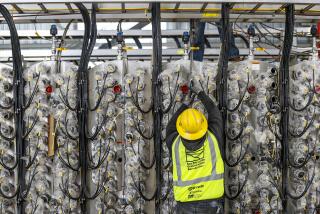Testing the Water : Beverly Hills: Officials hope an exploratory well finds a reserve of adequate quality and volume to allow the city to partially supply its own needs.
Beverly Hills this week moved closer toward construction of its own water system, which could mean lower rates for customers and independence from the city’s sole supplier, as engineers began digging a 600-foot-deep well on Burton Way to test the quality and volume of underground water.
The test well is a critical step in the proposed $12-million municipal water project, which officials said would mean less reliance on the Metropolitan Water District in case of disaster and drought.
“As recently as the Jan. 17 earthquake we had a situation when Metropolitan cut our water deliveries in half for about a day,” said city Public Services Director Dan Webster.
The water issue runs deep in the city. Those who supported an annexation attempt by Los Angeles 70 years ago reputedly left bottles of foul-smelling well water, ostensibly from Beverly Hills, on residents’ doorsteps with labels that said in part: “Drink sparingly, as it has laxative qualities.”
The annexation drive failed, however, and Beverly Hills had its own water until the 1970s, when officials switched to the Metropolitan Water District rather than undertake what they said would be a costly project to modernize the city system.
If the test well shows that the underground water is of good quality and volume, the City Council could decide to have six more wells dug and a water treatment plant built in what is known as the Industrial Area. The wells would supply about a quarter of the city’s water needs, with the remainder coming from the Metropolitan Water District.
Webster assured residents who recalled the foul-smelling water of the past that the treatment plant would purify the water.
The test well will cost $472,438 and take three to four months to construct.
It is expected that local water can be produced more cheaply than MWD-provided water.
“Metropolitan has embarked on a $6-billion capital project with a $500-million annual debt service, so we can expect to see their rates rise proportionately,” Webster said.
Water rates over the next 15 years are expected to increase at least 1% to 1.5% a year, not counting inflation, said MWD spokesman Jay Malinowski. He said the agency has generally supported independence efforts.
If the council approves the $12-million plan, the test well would be converted to a full-production well. An additional well would be constructed on Burton Way, and five more are proposed for Beverly Gardens park, which runs along Santa Monica Boulevard. Beverly Gardens would not be damaged by the wells, Webster said in response to worries voiced by some residents.
A sound enclosure was erected on the Burton Way median Tuesday, surrounding the construction equipment as the well is drilled. The acoustical barrier will be removed after the drilling. The pumping will not be disruptive to nearby residents, Webster said.
The only sign of the well above ground, according to engineers, will be three utility cabinets, each four to five feet high, near the well on the median strip.
In 1991, the City Council asked the Public Works Commission to look into the possibility of re-establishing local water wells. The following year, the Newport Beach firm of Boyle Engineering was commissioned to make preliminary studies of the ground water beneath Beverly Hills.
In November, 1992, the Public Works Commission recommended that the test well be drilled before the city spent millions of dollars to set up its own water supply. Boyle Engineering was authorized to design and operate the test well.
More to Read
Sign up for Essential California
The most important California stories and recommendations in your inbox every morning.
You may occasionally receive promotional content from the Los Angeles Times.









